
Bahawalpur is a city in the Punjab province of Pakistan. It is one of the ten largest cities of Pakistan and 6th most populous city of Punjab. Bahawalpur is the capital of Bahawalpur Division.

The Somnath temple(IAST: somanātha) or Deo Patan, is a Hindu temple located in Prabhas Patan, Veraval in Gujarat, India. It is one of the most sacred pilgrimage sites for Hindus and is the first among the twelve jyotirlinga shrines of Shiva. It is unclear when the first version of the Somnath temple was built, with estimates varying between the early centuries of the 1st millennium and about the 9th century CE. The temple is not mentioned in the ancient Sanskrit texts of Hinduism; while various texts, including the Mahabharata and Bhagavata Purana, mention a tirtha at Prabhas Patan on the coastline of Saurashtra, where the temple is presently located, there is no evidence that a temple existed at the site in ancient times.
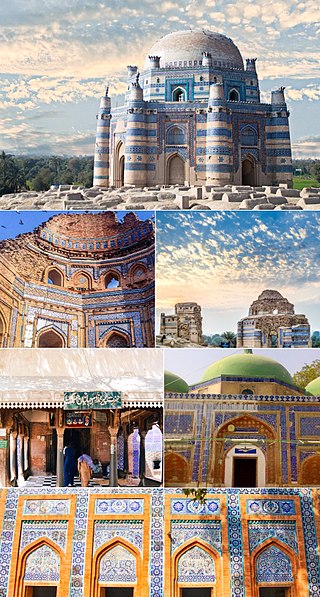
Uch, frequently referred to as Uch Sharīf, is a historic city in the southern part of Pakistan's Punjab province. Uch may have been founded as Alexandria on the Indus, a town founded by Alexander the Great during his invasion of the Indus Valley. Uch was an early stronghold of the Delhi Sultanate during the Muslim conquest of the subcontinent. It is also known as the home for the Naqvi/Bukhari's after the migration from Bukhara. Uch was a regional metropolitan centre between the 12th and 17th centuries, and became refuge for Muslim religious scholars fleeing persecution from other lands. Though Uch is now a relatively small city, it is renowned for its intact historic urban fabric, and for its collection of shrines dedicated to Muslim mystics (Sufis) from 12th-15th centuries that are embellished with extensive tile work, and were built in the distinct architectural style of southern Punjab.

The Lahaul and Spiti district in the Indian state of Himachal Pradesh consists of the two formerly separate districts of Lahaul and Spiti. The present administrative center is Kyelang in Lahaul. Before the two districts were merged, Kardang was the capital of Lahaul, and Dhankar the capital of Spiti. The district was formed in 1960 and is the fourth least populous district in India. It is the least densely populated district of India, according to the Census of India 2011.
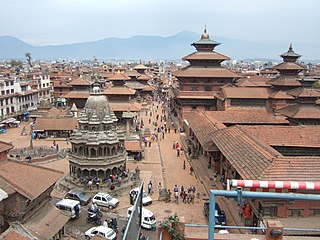
Lalitpur Metropolitan City is a metropolitan city and fourth most populous city of Nepal with 299,843 inhabitants living in 49,044 households per the 2021 census. It is located in the south-central part of Kathmandu Valley, a large valley in the high plateaus in central Nepal, at an altitude of 1,400 metres.

Termez is the capital of Surxondaryo Region in southern Uzbekistan. Administratively, it is a district-level city. Its population is 182,800 (2021). It is notable as the site of Alexander the Great's city Alexandria on the Oxus, as a center of early Buddhism, as a site of Muslim pilgrimage, and as a base of Soviet Union military operations in Afghanistan, accessible via the nearby Hairatan border crossing.

The Kathmandu Valley, also known as the Nepal Valley or Nepa Valley, National Capital Area, is a bowl-shaped valley located in the Himalayan mountains of Nepal. It lies at the crossroads of ancient civilizations of the Indian subcontinent and the broader Asian continent, and has at least 130 important monuments, including several pilgrimage sites for Hindus and Buddhists. There are seven World Heritage Sites within the valley.

The Enchey Monastery was established in 1909 above Gangtok, the capital city of Sikkim in the Northeastern Indian state. It belongs to the Nyingma order of Vajrayana Buddhism. The monastery built around the then small hamlet of Gangtok became a religious centre. The location was blessed by Lama Drupthob Karpo, a renowned exponent of tantric (adept) art in Buddhism with flying powers; initially a small Gompa was established by him after he flew from Maenam Hill in South Sikkim to this site. The literal meaning of Enchey Monastery is the "Solitary Monastery". Its sacredness is attributed to the belief that Khangchendzonga and Yabdean – the protecting deities – reside in this monastery. As, according to a legend, Guru Padmasambhava had subdued the spirits of the Khangchendzonga, Yabdean and Mahākāla here. In view of this legend, the religious significance of Enchey Monastery is deeply ingrained in every household in Gangtok. It is also believed that these powerful deities always fulfil the wishes of the devotees.

Rahim Yar Khan is a city in the Punjab province of Pakistan. It is the 16th most populous city of Pakistan and the capital of the Rahim Yar Khan District. The administration of the city is subdivided into nine Union Councils.

Derawar Fort is a fortress in Ahmadpur East Tehsil of Bahawalpur District in the Punjab, Pakistan. Approximately 20 km south of the city of Ahmedpur East, the forty bastions of Derawar are visible for many miles in the Cholistan Desert. The walls have a perimeter of 1500 metres and stand up to thirty metres high.

Bahawalnagar, is the capital city of Bahawalnagar District in the Punjab province of Pakistan. The city of Bahawalnagar is the headquarter of the district and tehsil as well. It is the 54th largest city of Pakistan by population according to the 2017 census. Old name of Bahawalnagar was Rojanwali/Ubbha. It was named Bahawalnagar in 1904 after Bahawal Khan V, the ruler of the Bahawalpur state comprising the present districts of Bahawalpur, Bahawalnagar and Rahim Yar Khan. It is 262 km (163 mi) south of Lahore and about 175 km (109 mi) miles east of Bahawalpur. It is 65 km (40 mi) far from District Pakpattan. River Sutlej passes on the northern side at a distance of about 6 miles.
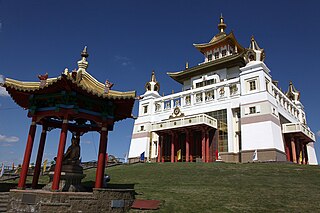
The Kalmyks are the only Mongolic-speaking people of Europe whose national religion is Buddhism. In 2016, 53.4% of the population surveyed identified themselves as Buddhist. They live in Kalmykia, a federal subject of Russia in the southwest. Kalmykia borders Dagestan to the south, Stavropol Krai to the southwest, Rostov Oblast to the west, Volgograd Oblast to the northwest, and Astrakhan Oblast to the east. The Caspian Sea borders Kalmykia to the southeast.
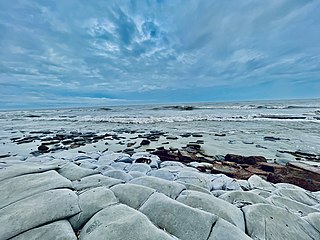
Kuakata is a town in southern Bangladesh known for its panoramic sea beach. Kuakata beach is a sandy expanse 18 kilometres (11 mi) long and 3 kilometres (1.9 mi) wide. From the beach one can have an unobstructed view of both sunrise and sunset over the Bay of Bengal.

Öndör Gegeen Zanabazar was the first Jebtsundamba Khutuktu and the first Bogd Gegeen or supreme spiritual authority, of the Gelugpa lineage of Tibetan Buddhism in Mongolia.
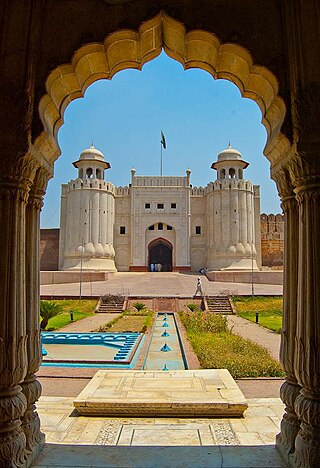
Tourism in Pakistan is a growing industry. In 2010, Lonely Planet termed Pakistan "tourism's 'next big thing'". The country is geographically and ethnically diverse, and has a number of historical and cultural heritage sites. Condé Nast Traveller ranked Pakistan The Best Holiday Destination for 2020 and also declared it the third-highest potential adventure destination in the world for 2020. As security in the country improves, tourism increases; in two years, it has increased by more than 300%. The Pakistani government had launched online visa services for 175 countries and 50 countries were offered visa on arrival, making visiting Pakistan easier. The country received an influx of travel vloggers, who promoted the characteristics of the country, such as in the Northern Pakistan, like Hunza and Skardu.

The Puning Temple, commonly called the Big Buddha Temple, is a Buddhist temple complex in Chengde, Hebei province, China. It was built in 1755 during the reign of the Qianlong Emperor in the Qing dynasty. It is near the Chengde Mountain Resort and alongside the equally famed Putuo Zongcheng Temple. Puning is one of the "Eight Outer Temples" of Chengde.
Pakistani architecture is intertwined with the architecture of the broader Indian subcontinent. The major architectural styles popular in the past were Temple, Indo-Islamic, Mughal and Indo-Saracenic architecture, all of which have many regional varieties. With the beginning of the Indus civilization around the middle of the 3rd millennium BC, for the first time in the area which encompasses today's Pakistan an advanced urban culture developed with large structural facilities, some of which survive to this day. This was followed by the Gandhara style of Buddhist architecture that borrowed elements from Ancient Greece. These remnants are visible in the Gandhara capital of Taxila.

The Government Palace, also known as the State Palace, is located on the north side of Sükhbaatar Square in Ulaanbaatar, the capital city of Mongolia. It houses various state organs such as the State Great Khural and offices of its members, as well as the offices of the President and Prime Minister. It is sometimes referred to by Ulaanbaatar residents as the "Saaral Ordon," or "Gray Palace" in the Mongolian language due to the exterior's former color.
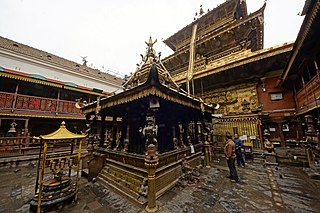
Hiraṇyavarṇa Mahāvihāra, also Kwa Baha: informally called The Golden Temple with literal meaning "Gold-colored Great Monastery", is a historical vihara situated in Patan, Nepal.
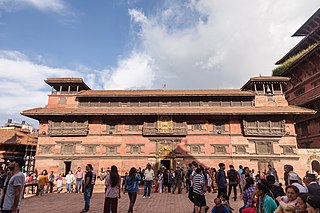
The Patan Museum is a museum located in Patan, Lalitpur, Nepal. The museum falls under the UNESCO's World Heritage Sites. The Patan Museum was inaugurated in 1997 by Late King Birendra Bir Bikram Shah. The Patan Museum displays the traditional sacred arts of Nepal in an illustrious architectural setting. Its home is an old residential court of Patan Durbar, one of the royal palaces of former Malla Kings of the Kathmandu Valley. The royal palace was built in 1734, on the site of a Buddhist monastery. The museum quadrangle is known as Keshav Narayan Chowk.



















